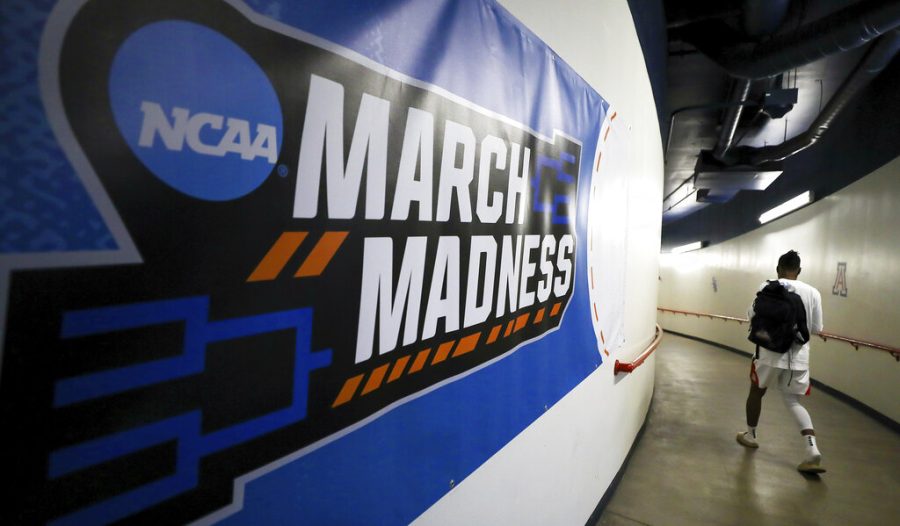COLUMN: NCAA should shift March Madness to 32-team bracket
The real Madness: NCAA’s 68-team playoff format
AP
Arizona guard Shaina Pellington walks past an NCAA March Madness sign in the hallways of McKale Center before Arizona’s game against UNLV in the first round of the NCAA women’s college basketball tournament March 19 in Tucson, Arizona. (Rebecca Sasnett/Arizona Daily Star via AP)
March 29, 2022
The NCAA Men’s Division I Basketball Tournament continues to bolster its branding as “March Madness” with a number of upsets occurring in the past two weeks. Within the action of the postseason, the true madness lies within the playoff format that structures the tournament.
The elephant(s) in the NCAA playoff room
When looking at the landscape of sports regulated by the NCAA, it’s evident that men’s basketball has the largest playoff format compared to most college sports by far.
The current tournament structure allows for 68 teams to qualify, about 20% of the total programs throughout the country. 32 teams are granted bids to the respective conference champions. The other 36 openings are deemed at-large bids that are determined by a selection committee on Selection Sunday.
The College Football Playoff currently utilizes the smallest playoff format, permitting only four teams the opportunity to compete for the National Championship. Is four too small? Maybe, but that is another column for another day.
The tournament for men’s soccer allows 48 teams to compete for a national title. Though the number seems large, it is reasonable. The present format permits just under a quarter of schools with a men’s soccer program, about 23%, to play in the postseason.
However, men’s basketball is far from being the only perpetrator in having a substantial number of playoff teams. Women’s basketball, baseball and volleyball permit 64 teams to compete in their respective postseasons, among others.
Cinderella stories are fun yet redundant
As magical as No. 15 St. Peter’s University’s run in this year’s bracket was to watch, the fact still stands that no team seeded lower than No. 8 in the tournament has won the championships since the tournament expanded to 64 teams in 1985, according to NCAA data.
It’s natural for people to root for the underdog. Unlike the traditional feel-good movie endings where the underdogs win the game, the college basketball playoffs prove why the top seeds are the top seeds.
While it’s entertaining to watch chaos unfold when lower-seeded teams make an impressive run in the playoffs, it’s nearly a given that they’ll be snuffed out by the powerhouses of the sport in due time.
The solution: Trimming off the bottom
If the NCAA were to elect to reduce the number of teams in the men’s basketball tournament, one solution would be to eliminate the round of 64 and the First Four games. The round of 32 would then be designated as the tournament’s first round instead, eliminating all at-large bids and thus seeds nine through 16.
Providing the NCAA maintained the division of the tournament between four regions, there would be a total of eight seeds in each region. This would mesh well with past data, as the champion in the past 36 tournaments has been seeded as high as No. 1 and as low as No. 8.
Only one No. 9 seed, one No. 10 seed, and four No. 11 seeded teams have come close to competing for the title since the tournament’s expansion in 1985. None advanced past the Final Four. The last team seeded below No. 8 to even sniff the Championship Game was UCLA in last year’s tournament. The No. 11 Bruins were eliminated in the Final Four of the 2021 tournament by No. 1 Gonzaga University on April 3, 2021.
Based on the data provided by the NCAA, there’s a strong case to be made to cut the pool to eight seeds per region. Until then, March Madness will continue as scheduled.
The Madness continues
The NCAA men’s tournament resumes Saturday with the Final Four round, beginning with a battle between No. 2 University of Kansas and No. 1 Villanova University at 5:09 p.m. CT. The following game between No. 8 University of North Carolina and No. 2 Duke University will tip-off at 7:49 p.m. CT.







